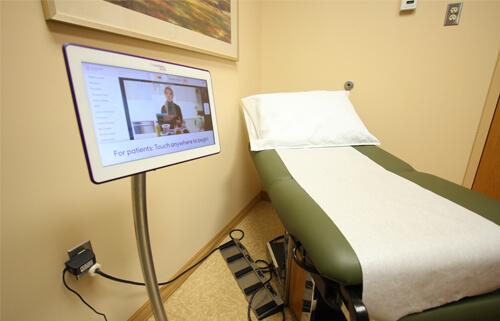Cancers of the gastrointestinal (GI) tract may lead to blockages of the flow of food, fluid and waste through the digestive system. Obstruction of the GI tract causes intolerable symptoms like nausea, vomiting and severe abdominal pain, which may become life-threatening. These situations can occur with esophageal, gastric (stomach) and colon cancers, and sometimes pancreatic cancer (which can lead to blockage of the upper small intestine), when tumors obstruct these areas.
Surgery used to be the only method available to relieve these obstructions, but now a less invasive option is available: the placement of luminal stents in the GI tract. This specialized endoscopic procedure has proven a successful alternative to therapy in over 90 percent of cases where it has been used.

What Is Involved in GI Luminal Stenting?
The placement of stents through endoscopy relieves the obstruction by holding open the area of the GI tract that was previously blocked. A stent is a hollow tube made up of a fine, flexible wire, which is tacked into a mesh that looks like a chain-link fence. The stent is coiled up into a size similar to a thin pencil. The stents used range in size, but are typically about one inch in diameter after they open. Some stents have a thin film covering the outside to prevent tumors from growing into the center, which can lead to blockage.
As highly trained gastroenterologists, therapeutic endoscopists like your GHP physician have the special training and years of experience needed to perform this challenging procedure with precision, skill and minimal risk of complications.
How Do You Prepare for a GI Stent Surgery?
Before having GI stent surgery, your GHP physician will go over some pre-operative instructions that you will need to follow in the days before your procedure. Following these instructions is essential to limit surgery risks and provide the best results.
- Stop certain medications. Prior to surgery, your GHP physician and their staff will need to be made aware of all medications that you are taking, especially blood-thinning medications. These may include Coumadin (warfarin), Plavix (clopidogrel), Xarelto (rivaroxaban), Pradaxa (dabigatran), Eliquis (apixaban) and Lovenox (enoxaparin). Since the use of these medications increases the risk of excessive bleeding, they should be stopped prior to your procedure. If you are using insulin, the dosage or timing will also need to be adjusted the day of the procedure. Doctor-prescribed aspirin may be continued before your procedure. In addition, your GHP physician asks that you provide them with a list of medications to which you are allergic.
- Stop eating hours beforehand (for upper GI tract exam). Refrain from eating anything starting the midnight before your procedure is scheduled.
- Use our cleansing routine the day before (for lower GI tract exam). your GHP physician’s office will prescribe a cleansing routine (or “prep”), which consists of a powerful liquid laxative that is to be taken the day before the procedure in order to prepare your bowels. This cleansing routine is the MOST IMPORTANT part of the procedure. Your GHP physician’s office will give you further instructions on following this cleansing routine and other details to follow on the day before the procedure. These instructions include following a clear liquid diet the day before the procedure, and drinking lots of liquids.
What Happens During GI Luminal Stenting?
Endoscopy for GI luminal stenting is usually performed as an outpatient procedure. Upon checking in, you will be escorted to the “pre-op” area where an IV will be placed and nurses will take down your medical information. Afterwards, you will meet with an anesthesiologist to discuss the sedation used for the procedure.
You will then be taken to a procedure room and connected to monitors that will monitor your blood pressure, heart rate and blood oxygen levels throughout the course of the procedure. Once this is finished, you will then be sedated for the duration of the procedure (not awakening until after it is complete). The procedure takes an average of 20-40 minutes to complete.
For the procedure, you will be placed on a special X-ray table once you are completely sedated. Endoscopy, where a thin tube with a camera on it is inserted either by an upper endoscope (into the esophagus, stomach and duodenum) or colonoscopy (into the colon), is performed to evaluate the area blocked by a tumor. This process is accomplished with the use of fluoroscopy (where an X-ray beam is passed through the area being examined and the beam transmits a live image onto a monitor). The blocked section of GI tract is evaluated by endoscopy, and a guidewire is advanced past the blockage using X-ray guidance. The stent delivery system is advanced through the endoscope across the blockage, where the stent then expands and opens the narrowed area of the GI tract.
What Should You Expect after the Procedure?
After the procedure, you will be returned to the “post-op” area to recover from sedation. During this time, you will be monitored for any potential complications from the procedure and/or sedation. When you are fully recovered, your GHP physician will give you an explanation of the findings from the procedure (this report is preliminary, however, and it may take several days for the final results of the biopsies to return). Along with the findings, your GHP physician will provide you with a copy of the procedure report, patient information handouts and follow-up instructions.
Due to the effects of sedation, patients are instructed not to drive, operate machinery or make important decisions for the 24 hours following your procedure. We recommend that you have someone drive you home after surgery. your GHP physician recommends a clear liquid diet for the first two to three days after treatment, followed by a bland diet. The nursing staff will review these and other important post-op instructions with you prior to discharge.
Most patients will feel discomfort after a stent is placed. Patients with esophageal cancer may experience moderate discomfort in their chest, and patients with stomach, duodenal or colon stents may experience moderate abdominal discomfort. This is due to the stent gradually expanding and pushing against the tumor and irritating the nerves. The discomfort typically lasts about three to five days, and then subsides. Your GHP physician will prescribe pain medication, if necessary, to help relieve the discomfort.
Possible Complications and Risks
Possible complications include perforation, or a tear, in the lining of the esophagus, stomach, intestine or colon. This complication is rare, occurring in less than 5 percent of cases. If it occurs, surgery may be necessary to repair the perforation.
Bleeding in small amounts is common due to the stent rubbing against the tumor.
Rarely, stents can move or migrate. When they do, patients will experience the symptoms they had previously as a result of obstruction. If this occurs, contact your GHP physician’s office. Treatment of a stent that has migrated may include removal or replacement of the stent.
Uncommon risks from sedation used for the endoscopy procedure include reactions to sedation medications, possible aspiration of stomach contents into the lungs and complications from heart and lung diseases.
All of these risks must be balanced against the potential benefits of the procedure and the risks of alternative approaches to the condition.
Disclaimer: This information is intended to provide general guidance and does not provide definitive medical advice. It is not a definitive basis for diagnosis or treatment in any particular case. This material does not cover all information and is not intended as a substitute for professional medical care. It is important that you consult your doctor regarding your specific condition, contraindications and potential complications.





